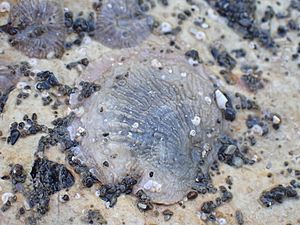Monia zelandica facts for kids
Quick facts for kids Monia zelandicaTemporal range: Pliocene to Recent
|
|
|---|---|
 |
|
| Scientific classification | |
| Genus: |
Monia
|
| Species: |
zelandica
|
| Synonyms | |
|
Anomia zelandica Gray, 1843 |
|
Monia zelandica is a type of marine animal. It is a bivalve mollusc, which means it has two shells. This creature belongs to the family called Anomiidae. These are often known as "jingle shells."
Contents
What is a Jingle Shell?
Jingle shells are a special kind of mollusc. They are related to clams, oysters, and mussels. Like these animals, Monia zelandica has two shells that protect its soft body. These shells are often thin and somewhat see-through.
Why Are They Called Jingle Shells?
The name "jingle shells" comes from how their shells sound. When many empty shells wash up on the beach, they can make a soft jingling sound. This happens when they are moved by waves or wind. It's like tiny bells ringing.
Where Monia zelandica Lives
Monia zelandica lives in the ocean. You can find these bivalves in the waters around New Zealand and Australia. They prefer to live in coastal areas. They often attach themselves to rocks or other hard surfaces.
How They Live in the Ocean
These bivalves are filter feeders. This means they get their food by filtering water. They draw water into their shells. Then, they capture tiny bits of food, like plankton, from the water. This helps keep the ocean clean.
Shell Features
The shells of Monia zelandica are usually round or oval. They can be a variety of colors. Sometimes they are white, yellow, or even greenish. One shell is often flatter than the other. This helps them attach to surfaces.
How They Attach to Surfaces
Monia zelandica uses a special "foot" to attach itself. This foot produces a strong, sticky material. This material hardens into tough threads. These threads are called byssal threads. They act like anchors, holding the shell firmly in place. This keeps the bivalve from being washed away by currents.
Discovery of Monia zelandica
This species was first described in 1843. A scientist named John Edward Gray officially named it. Scientists give each species a unique name. This helps everyone know exactly which animal they are talking about.
Further Reading
- Powell A W B, New Zealand Mollusca, William Collins Publishers Ltd, Auckland, New Zealand 1979 ISBN: 0-00-216906-1

